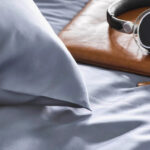SUFFERING FROM DUST MITE ALLERGY? 7 TIPS FOR YOUR BEDROOM
Are you suffering from dust mite allergy? Did you know that 25% of all peopel suffer from this annoying allergy? Many people don’t know it and think they have caught a nasty cold or ‘just’ have a headache again. Nothing is more annoying than waking up with a stuffy nose. If you suffer from a dust mite allergy, it is important to adapt your home accordingly. Dust mites exist in every house, no matter how clean it is. Especially the bedroom is a room to pay special attention to. After all, you spend about a third of your life sleeping. Fortunately, with the right tips you can alleviate or even cure many dust mite allergy complaints.
What is house dust mite allergy?
But first, what exactly is a dust mite? A house dust mite is a tiny animal smaller than half a millimeter and barely visible. House dust mites feel best in dark, warm and humid places, preferably at a temperature of about 25 degrees Celsius. They keep themselves alive of human and animal dander, bacteria and fungi. It is the feces of the dust mites that are the cause of your and my allergic reaction.
Dust mites are most commonly found in dust particles from house dust, carpets, bedding, duvets and curtains. These dust particles also float in the air, especially in houses and buildings where cleaning is poor, there is little ventilation and where many people and/or animals live.
When are you most bothered by dust mites?
Dust mites are found in almost every home, all year round. Unlike hay fever, a dust mite allergy is not seasonal. But especially in autumn and winter there is an increase in the number of dust mites. In cold months there is usually less ventilation and the heating is often turned on again. An ideal living environment for dust mites. The allergic complaints are the most severe during these seasons.
Symptoms of dust mite allergy
What are the symptoms of dust mite allergy? People with an allergy to dust mites can have many different complaints, such as:
* waking up with a runny (Rhinorrhea) or stuffy nose
* frequent sneezing
* tickling cough
* red, swollen or watery eyes
* shortness of breath after making the bed
* headache
* fatigue and lethargy
* asthma
* eczema or itching
7 Tips to beat dust mites in your bedroom
Completely removing dust mites from your bedroom is almost impossible. Fortunately, there are some tips you can apply to reduce the number of dust mites and therefore your allergy complaints.
1. Grab the cleaning cloth
The most important thing is to keep your bedroom as clean as possible. Dust mites love dust, so if there is no dust there are fewer dust mites. Wipe the shelves with a damp cloth and use the vacuum cleaner at least once a week. Don’t forget to take the headboard with you. Furthermore, you prefer a smooth floor and no carpet.
2. Ventilate well
Make sure you ventilate your bedroom well. Dust mites, mold… they love warm, moist spaces. If you ventilate regularly, this ensures that the humidity is not too high. You can chase away dust mites with the fresh, cold air.
3. Choose a minimalist design
Put as little as possible in your bedroom. Dresses, stuffed animals, TV and books – try to minimize it. The more stuff you have, the more dust traps you get in your bedroom. A minimalist bedroom design is a good choice. It also provides peace and quiet in your bedroom.
4. Keep your pets out of the bedroom (Yes, we know you don’t like to hear this..)
Pets are nice to have, but it is better to leave them out of your bedroom. They lose hair and dander, something that dust mites love.
5. Open your duvet
It may sound crazy, but you don’t have to make your bed every day. Feel free to open the duvet. This way the heat can escape and you shine light on it.
6. Change clothes in a different room
If possible, do not change clothes in your bedroom but in another room. When dressing and undressing you lose skin flakes, something that dust mites love. Don’t keep worn clothes and shoes in the room where you want to enjoy a good night’s sleep.
7. Use anti-allergic bedding
Use antibacterial bedding such as TENCEL™ Lyocell. This is hypoallergenic and suitable for anyone with a dust mite allergy. The smooth fiber prevents dust mites from nesting in it. So optimally hygienic. By the way, you only need to wash TENCEL™ bedding at 30 degrees Celsius which is also extra sustainable.
In our assortment we have 100% TENCEL™ duvets, duvet covers, fitted sheets and pillowcases. View our full anti-allergic bedding range.
(source: National Sleep Foundation)
Want to stay informed about our sleeping tips and fun promotions? Sign up here for our newsletter for free and instantly receive 10% discount on your first purchase.




